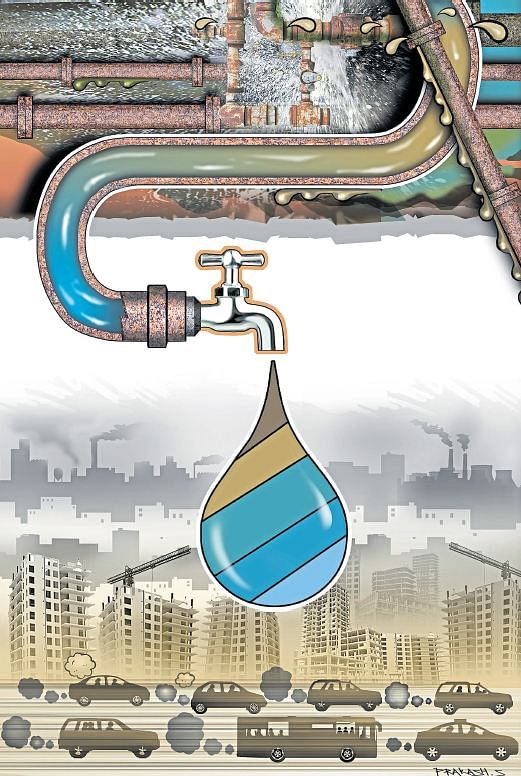
Perennially thirsty, Bengaluru has had global attention riveted on its status as a city doomed to run out of water in the near future. This has been debated, but to add to this disturbing prospect, a new dimension has come to the fore: The quality of its water is unfit for drinking.
That the city has been clubbed with the likes of Delhi, Chennai and Kolkata in the report recently released by the Union Ministry of Consumer Affairs, Food and Public Distribution, offers little comfort. The reality is this: The spotlight has suddenly shifted to an area hitherto ignored.
But the Bangalore Water Supply and Sewerage Board (BWSSB) has contested the claim, questioning the lack of transparency in the parameters employed by the Bureau of Indian Standards (BIS). A top Indian Institute of Science (IISc) researcher has also raised his doubts, suspecting that global water treatment firms could be playing a role.
Continuous monitoring
The Board has clarified that the quality of water supplied in the city “is continuously monitored both through in house, well-equipped laboratories and also through NABL-accredited external labs to maintain the fidelity of the system.”
Its contention is this: Only 1.14% of the total sample size of 33,567 it tested from October 2018 to November 2019 has failed. This is much less than the permissible limit of 5% prescribed by the World Health Organisation (WHO).
The Board collects 80-100 samples for daily analysis at its lab. “As against the sample size of 1 per 10,000 population in a month as per WHO, we are roughly collecting 2.4 per 10,000 population to maintain the quality of water,” the Board’s Engineer-in-Chief elaborates.
The BIS tests water quality under 48 parameters. But in the latest study, parameters related to the presence of radioactive substances and free residual chlorine were excluded. The test samples were subjected to organoleptic, physical, bacteriological and chemical tests and checks linked to toxic substances.
BIS quality parameters
The BWSSB’s issue with BIS is that the Bureau has not furnished the methodology, places of collection of samples and parameter details. “We have communicated to BIS to make the report available to us immediately so that it can be analysed and facts can be informed to the public and remedial action if required can be taken.”
But beyond the Board’s contentions, there is enough evidence on the ground to show that contamination is a real issue. Sewage-mixed water often gets supplied to households, particularly in the newly added BBMP areas on the outskirts. Water leakage and pilferage, an issue the BWSSB has been struggling to contain, raises the risk of contamination.
Not convinced
Not everyone is convinced by the Board’s clarification. “Within the city, the parameters of turbidity, Ph, alkalinity, residual chlorine and bacteriological tests have to be done on all samples,” notes water expert and retired BWSSB chief engineer M N Thippeswamy.
For a population as large as Bengaluru, he contends, at least 1,000 samples have to be tested. WHO standards insist that 95% of these should be tested fit for drinking “Does the Board have the required equipment and are tests done properly. It is a big question mark,” he says.
The Board has booster chlorination / re-chlorination plants at about 35 locations. These are required to compensate for dissipation due to flow of the water over long distances, once chlorination is completed at the water treatment plants en route from Cauvery.
Question of efficiency
The standards mandate that 0.2mg/litre of residual chlorine is left in the water to ensure that it is free of pathogenic bacteria. “How many of these re-chlorination plants are working efficiently is another question.”
In December 2018, a study titled “Drinking water contamination from peri-urban Bengaluru” published in the journal ‘Current Science’ had brought out this stark reality. This study was focused on drinking water quality in households from eight villages near the Vrishabhavathi-Byaramangala reservoir.
Water sample analysis from the villages, Anchipura village, Anchipura Colony, Bannigiri, Chikkakuntanahalli, Kodiyala Keranahalli, Kodiyala, Mahadevpura and Kodihalli found that the contamination at source was as high as 80%. They also presented a moderate to high risk for diarrhoea.
On E.coli counts, only 20.6 per cent of the tested water samples complied with the WHO’s permissible limits. A high 93% had coliform contamination while the proportion of total dissolved solids, calcium, magnesium, total alkalinity and nitrates was equally high.
Disturbing trend
But even as early as 2013, the deterioration in water quality was clearly evident. A Ward Quality Databook prepared by Janaagraha and IChangeMyCity, based on multiple parameters across the city’s 198 BBMP wards, had shown a disturbing trend.
Out of the 7,910 households surveyed for water quality, 5,734 had contaminated water. This accounted for a high 72%. Water samples were tested for bacteriological contamination, the source surveyed and frequency of water supply tracked for the study.
Coliform bacteria, one of the contaminants tested for the Databook, are known to cause diarrhoea, urinary tract infections, gastroenteritis and typhoid.
Quantity over quality
The implication is clear: Water quality is an issue that has always been troubling Bengalureans. But, as experts point out, the spotlight has always been on quantity, with even the Karnataka State Pollution Control Board (KSPCB) limiting itself to monitoring wastewater and not drinking water. Way back in 2012, the Board had articulated a plan for a Bengaluru Water Quality mapping index. Seven years later, there is no sign of any such index. As lakhs of Bengalureans fall prey to a concoction of water-borne diseases every year, water quality remains under a cloud despite official claims